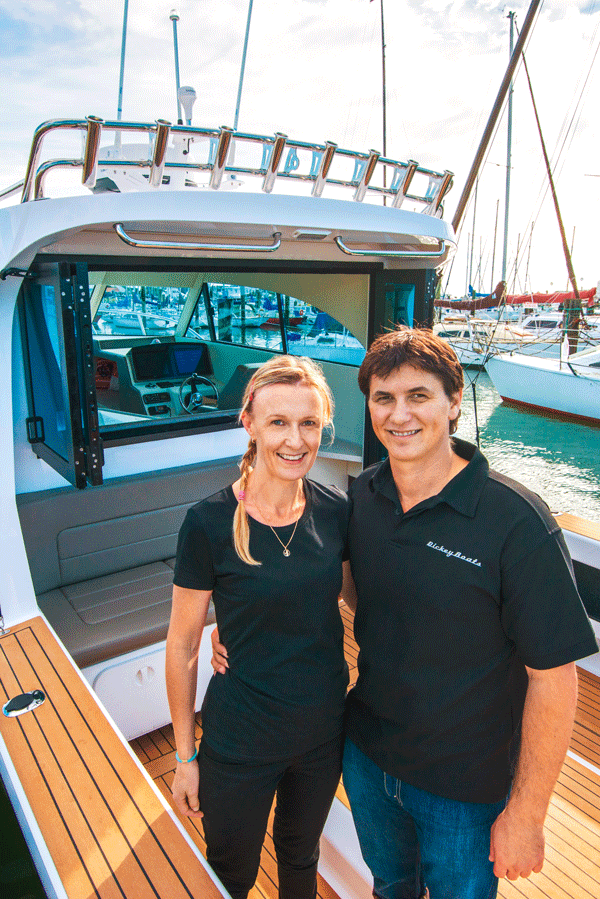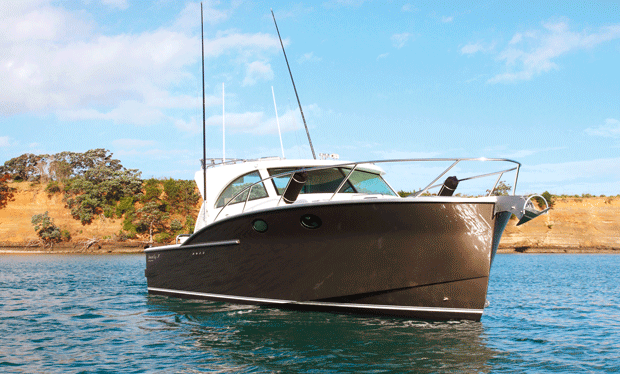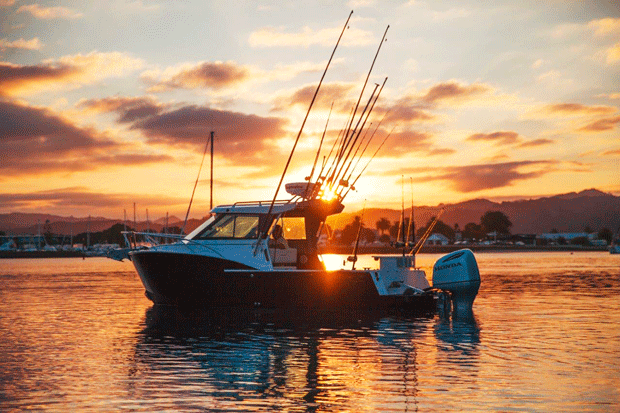The Napier business bringing super yacht technology down to size

Jason & Tristin Dickey talk us through how they brought superyacht technology down to size in a range of luxuriously fitted aluminium boats.
Words: Rebecca Hayter
This article was first published in the November/December 2016 issue of NZ Life & Leisure.
When Jason and Tristin Dickey took the first boat they had designed and built to the 2007 Hutchwilco New Zealand Boat Show, there were two reactions: “What the heck is that?”… and… “Wow, I get that. That’s amazing.” “That” was the Dickey Semifly 28; it had big-boat thinking in just 28 feet (8.5 metres). Most aluminium boats at that time were workhorses: bare aluminium hulls with camping-style facilities. The Dickey Semifly 28 was made of aluminium but inside and out it had the smooth surfaces of a fibreglass boat. Its generous internal volume allowed apartment-style living – including space to entertain and hot-and-cold running comfort.
A major talking point was the plumb bow, which was straight up and down, rather than pointy. Jason had developed the concept during 10 years overseas, including three global circumnavigations on superyachts. He trained in mechanical engineering, which taught him European construction techniques and how to run a commercial shipyard. “Technology always excites me,” Jason says. “I saw a lot of style and shape that you could get into aluminium or sheet metal.”
Jason met his wife Tristin in 2005; they moved from Auckland to Napier where they could afford to build a workshop. “We literally put everything into the design stage for about three years,” he says. “The plumb bow was a massive decision.” It was based on providing a comfortable, quiet ride in New Zealand’s boisterous sea conditions and achieving good fuel economy. He designed the boat for CNC (computer numerically controlled) construction in which the aluminium panels are machine cut via computer files. The initial capital outlay is offset by being able to achieve perfect, identical cuts every time. At the time, Jason says, most manufacturers of small aluminium boats were cutting panels by hand.

ELEVATOR PITCH
Dickey Boats continues to be first. In 2014 it fitted CZone which allows the skipper to display and run all the boat’s systems – pumps, navigation, communications – from an iPad and to select “cruising”, “fishing” or “night” mode on a key fob. For example, fishing mode instantly switches on the cockpit lights, and pumps for tuna tubes and hand wash without touching the switchboard. In 2015, Dickey was first in New Zealand to feature joystick steering on an outboard-powered boat.
HEADWINDS
The Dickey Semifly 28 attracted an order for a Semifly 32, with orders pending for the Semifly 40. But as the Semifly 32 reached completion, the GFC hit. “We were building big boats and that big-boat market died overnight,” Tristin says. “We had to move quickly to diversify. Being small and design focused we could listen to what people wanted – and so the trailerboats were born. Everyone had been riding this massive wave and if that had continued perhaps we wouldn’t have developed the range as we did.”
TAILWINDS
In the first three years Dickey Boats developed five new models and designed boats for other clients. In 2010 the company built a factory and staff expanded from three to eight, including an internal designer. They sold boats in New Zealand and to customers in Switzerland, Sweden and the Bahamas. Dickey Boats has also won numerous awards at the Hutchwilco NZ Boat Show.
What next? Dickey Boats’ developing export strategy is to target Sydney as a confined market. If Dickey were marketed throughout Australia, it would be unable to meet demand. dickeyboats.com

LESSON
‘The hardest bit about growth is knowing what you’re going to outgrow next. You might need more tools or a sub-contractor can no longer keep up or you outgrow the purchasing system because there are nine boats in production with 7500 parts in storage’
THE NUMBERS
$200,000 to $2 million for boats from 7.5m to 58ft (17.6m)
24 staff
100% growth every year
60 boats in nine years
2 45ft (13.7m) boats in build
Love this story? Subscribe now!
 This article first appeared in NZ Life & Leisure Magazine.
This article first appeared in NZ Life & Leisure Magazine.
